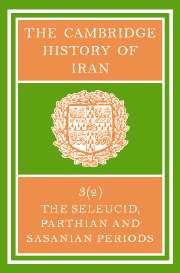30 - The Development of the Arts in Transoxiana
from PART 7 - ART HISTORY
Published online by Cambridge University Press: 28 March 2008
Summary
In the Persian epic Firdausī portrayed his conception of the ancient past as a tripartite world in which Iran and Tūrān interacted as the principal antagonists. Tūrān, or Transoxiana, was there vaguely defined as the area between the Oxus River and Khotan “on the frontiers of China”. Hudud'āl-alam gives a more detailed geographical picture of Transoxiana in the 10th century: “The Marches (hudūd) of Transoxiana are scattered districts, some lying to the east of Transoxiana, and some to the west of it. East of the Eastern Marches of Transoxiana are the borders of Tibet and Hindūstān; south of them, the [Marches] of Khurāsān; west of them, the borders of Chaghāniyān; and north of them, the borders of Surūshana which belong to Transoxiana… This is a vast, prosperous, and very pleasant country. It is the Gate of Turkestan and a resort of merchants.” Today Transoxiana would be the roughly rectangular area between the Āmū Daryā (Oxus) and the Syr Daryā (Jaxartes) rivers, which flow into the Aral Sea from the Pamir and Tien Shan mountain ranges respectively.
In antiquity the river boundaries of Transoxiana were neither impassable barriers nor isolating features. The lower course of the Āmū Daryā, which lies in the Turkmen plain, is accessible from the flat-lands surrounding the Aral Sea. The middle course of the river rises northeast of Marv (Murghāb valley), and its upper course forms the present-day borders between Afghanistan and the Soviet republics of Uzbekistan and Tajikistan as far as Badakhshān in the Pamir range.
- Type
- Chapter
- Information
- The Cambridge History of IranSeleucid Parthian, pp. 1130 - 1148Publisher: Cambridge University PressPrint publication year: 1983



